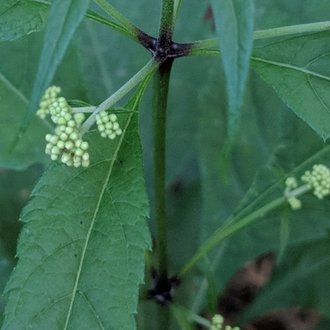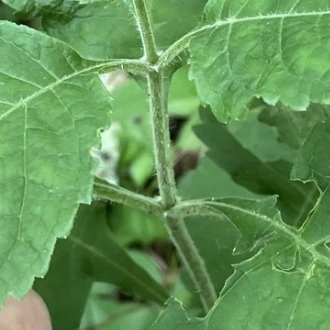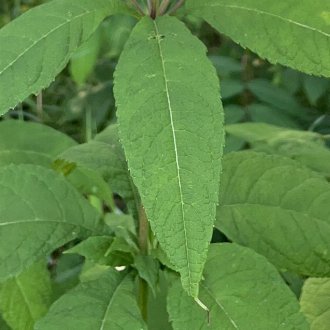Sweetscented Joe Pye Weed vs Appalachian Joe Pye Weed
This guide is under construction and has not been published yet. It may have errors. When in doubt, double-check other sources for definitive ID.These two species are visually similar and inhabit similar habitats, but they can be distinguished by details of pubescence and length and shape of leaves and petioles. We are having trouble completing this guide for lack of images. E. steelei has a restricted range and is also restricted to higher elevations.
Sweetscented Joe Pye Weed (Eutrochium purpureum) | Appalachian Joe Pye Weed (Eutrochium steelei) |
A tall perennial of partly-shaded areas, preferring drier and shadier conditions than other Eutrochium species. | The least-common species of Joe-Pye, restricted to a small range in the southern Appalachians. |
Stems may have some pubescence in the inflorescence, but lack pubescence lower down on the stem. Stems are usually solid green constrasting with strong purple at nodes, extending onto petioles. Photo © Mirko Schoenitz, Public Domain. | Stems are usually consistently glandular-pubescent throughout. Stems may be purple, but usually lack a strong contrast between at nodes and green in-between. Photo © Brandon Wheeler, Public Domain. |
Petioles average much longer (5–15mm.) | Petioles average much shorter (1.3–2.8mm, rarely to 3.6mm.) |
Leaves average narrower relative to their length (2.5-4x as long as they are wide.) Photo © Morgan C, CC BY 4.0. | Leaves average broader relative to their length (2-2.5x as long as they are wide.) |
Underside of leaves has a few resin dots; usually lacks hairs except on major veins, except for a small population in the Piedmont (var. carolinianum) that has extremely fine hair. | Underside of leaves is glandular-pubescent. |
References & External Resources
These short lists show only links helpful for ID. For a complete list of references and resources also covering other aspects of ecology, visit the links section of the full article on each plant, which is the first entry here.





